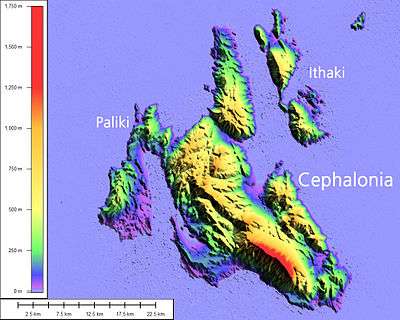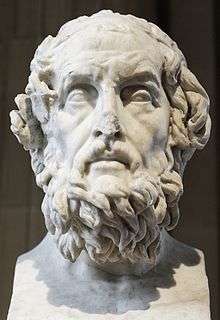Odysseus Unbound
Odysseus Unbound (2005), by Robert Bittlestone with the assistance of Professor James Diggle of Cambridge University and Professor John Underhill of the University of Edinburgh, puts forth a theory that Paliki, a peninsula of Kefalonia, is the location of Homer's Ithaca, the home of Odysseus in Homer's Odyssey.[1]

Argument
The initial insight leading to the argument came from a tourist roadmap of the Paliki area, which Bittlestone purchased following a visit to the region, in preparation for another visit — one this time to the modern island known as "Ithaki" (Ithaca). Scholars for centuries have noticed that the island of Ithaki does not correspond to the detailed descriptions of the home of Odysseus offered by Homer in the Odyssey. Many explanations, from simple ignorance on Homer's part to "poetic license", have been used to account for the discrepancies.
Bittlestone had noticed, however, that the western peninsula of Kefalonia appeared to correspond with the principal clues offered by Homer, yet it is not an island. On his previous trip, though, his daughter's question, about an inland hilltop fortress on neighboring Lefkas island — "But why did they build it here?" — had led to the thought that sea levels in the area might once have been much higher, that in turn leading to the idea that higher sea levels might once have cut off the Paliki peninsula from its mainland, Kefalonia, making Paliki an island. The tourist map seemed to confirm this: on it, Bittlestone saw, the neck of land connecting Paliki to Kefalonia did appear to be very narrow and, more importantly in this mountainous region, relatively low along most of its length.
Confirmation was needed from at least two sources: philology — to ensure that the Homeric account of "Ithaca" was properly understood — and geology, to establish among other points that the narrow neck of land on Kefalonia could in fact have been the site of a sea channel, in the times of Homer and of Odysseus.

James Diggle, co-author of the study which argued that Paliki was Homer's "Ithaca",[2] is Professor of Greek and Latin at Cambridge University and a recognized authority on Ancient Greek texts. His detailed analysis of the "clues" contained both in Homer and in Strabo and other texts was crucial to supporting the Paliki argument.
Various lists of philological clues were assembled, derived from the ancient texts, to identify specific geographic details which might correspond to modern locations. For example 26 such locations were identified "in or near Homer's 'Ithaca'":[3]
- Ithaca — Odysseus' island off the west coast of Greece: location disputed
- Ithaca city — Its capital
- Ithaca harbor — Its harbor, adjacent to the city
- Same — The island opposite Ithaca, also known as Samos Island: location disputed
- Doulichion — Another island nearby: location disputed
- Zakynthos — One of the Ionian islands to the south: location known
- (etc.)
— and similar lists were made for "Odysseus' Palace",[4] "Doulichion",[5] and other locations.
A list of 32 such "clues" also was drawn up by the team, and a chart prepared, showing how other "Ithaca" locations suggested by previous theories — including the modern island of Ithaki — do not correspond, while the Paliki peninsula does:[6]
- Clue 1 — Does Ithaca lie low and to the west, the furthest out to sea of a group of neighboring islands, called Ithaca, Samos Island, Doulichion and Zakynthos?
- Clue 2 — Does Ithaca contain a bay with two distinctive jutting headlands?
- Clue 3 — Can a ship leave Ithaca harbor driven by a stiff following wind from the west?
- Clue 4 — Is there a two-harbored island called Asteris in the straits between Ithaca and Samos Island, with windy heights that would enable an ambush to take place?
- (etc.)
Geology
John Underhill, the third co-author of the study,[7] is Professor of Stratigraphy at the University of Edinburgh and a recognized authority on the structure and stratigraphy of sedimentary basins, and on the geology of the Ionian islands. His contributions in several areas, including investigation of the prior existence of "Strabo's Channel", and analyses of factors such as tectonic uplift, and erosion, also were crucial in authenticating Paliki.
The initial geological problem posed by Bittlestone — whether sea levels in the region might once have been higher, such that the narrow isthmus now connecting Paliki to the rest of Kefalonia might once have been submerged — turned out to be exactly the opposite, the sea didn't fall but the land rose, and the periodic earthquakes that triggered this upthrust simultaneously brought down catastrophic rockfalls. Paliki sits on the edge of the European continental shelf, which is being pushed continuously from the southwest by the African plate, in a plate tectonics shift which causes constant earthquakes: the Ionian islands were devastated by one such earthquake as recently as 1953, and there have been many before that. Observation of many geologic clues in the region shows that uplift — the result of earthquakes — has in fact occurred.
The insufficiency of the uplift to account for the altitude of some of the terrain now at the channel site is explained by high volume landslips similar to those that impacted northern Pakistan in 2005: earth and rocks and whole sections of the mountainside itself falling from the high Kefalonia mountains which line the eastern edge of the isthmus, down onto what once had been "Strabo's channel". Findings of ancient Greek structures now buried beneath this erosion provided part of the confirmation for the proposal, which now is to be subjected to a battery of geological tests.
On the other hand, one objection to the Odysseus Unbound theory is that (whether or not subsequent landslips could have converted it into the current landform) the hypothesized channel was an implausible geographical structure. It is not clear what natural processes could have created a deep valley linking two arms of the same sea which was several miles long yet only a hundred yards or so wide at sea-level throughout. (If it existed today, it would be a world-famous natural phenomenon.)
The transmission of texts
One of the great mysteries of Homeric scholarship, too, has been how Homer — whoever he was, or whoever "they" were — living in the Aegean in what now is western Turkey, where he/they are said to have lived, might have acquired such detailed knowledge of "Ithaca" / Paliki as appears in his Odyssey. The suggestion made in the study[8] is that folk-tales of the "Ithacans" containing detailed references to the landscape were carried by them, during their Greek Dark Ages migrations during the time-of-troubles which followed the Mycenean / Trojan war period, to the Greek mainland and from there to western Anatolia. At that final resting place for the migration of the Ionians, then, roving bards of the type described by Milman Parry picked up the "Ithacan" tales, perhaps, and wove them together into the Odyssey: for the entertainment and edification of audiences who knew Paliki well, and initially were very homesick, and longed for it.
Notes
- Green, Peter (2006-11-30). "Finding Ithaca". ISSN 0028-7504. Retrieved 2020-03-26.
- Odysseus Unbound, particularly Appendix 1.
- Odysseus Unbound, Figure 3.3, p. 31.
- Odysseus Unbound, Figure 17.2, p. 194.
- Odysseus Unbound, Figure 21.12, p. 270.
- Odysseus Unbound, Appendix 4.
- Odysseus Unbound, particularly Appendix 2.
- Odysseus Unbound, Chapter 26 "Exodus", p. 342ff, particularly Figure 26.1 at p. 343.
References
- Bittlestone, Robert; James Diggle; John Underhill (2005). Odysseus Unbound: The Search for Homer’s Ithaca. Cambridge, UK: Cambridge University Press. ISBN 0-521-85357-5.
See also
- Homer's Ithaca
- Ithaca
- Kefalonia
- Trojan war